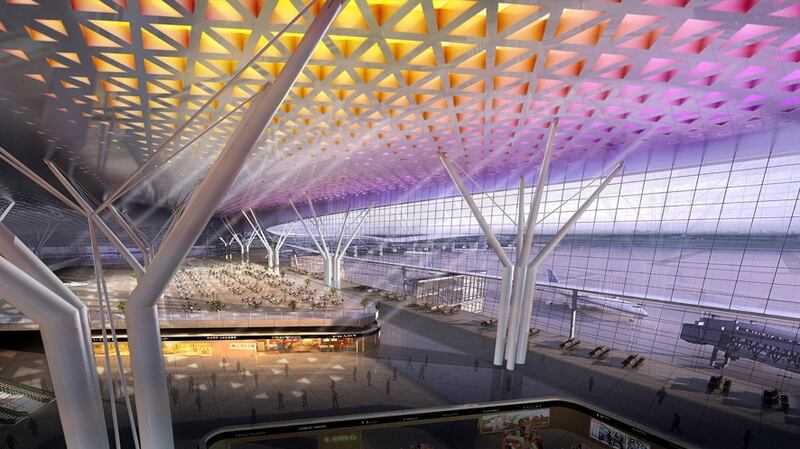One morning in 1977 Brian Eno, electronica pioneer and former synthesiser player for Roxy Music, was sitting in an airport in Cologne, in what was then West Germany, and was deeply disturbed.
“The light was beautiful. The building was beautiful,” Eno told a Dutch television interviewer. “They spent hundreds of millions of pounds on the architecture and everything – except the music.”
Eno was so unhappy with the music (or maybe we should say inspired) that he recorded Music for Airports, intended to serve as a soundtrack for the harried air traveller. The album is hailed today as a high-water mark of ambient music.

Nearly 40 years later, during a layover in Madrid’s airport, I thought about Eno and how, by today’s standards, his complaint about airports and bad music almost seems quaint.
Airports have been drastically transformed since the 1970s, when you could smoke anywhere, stroll leisurely through security and hug your loved one at the gate before boarding.
Passing through security these days takes forever and sometimes borders on harassment. The lighting is too bright; almost all the chairs have armrests, preventing you from splaying out. And the ambient noise – the endless gate changes, the last calls for boarding, the TVs with breaking news – makes it almost impossible to relax. It’s no wonder that passengers often feel more like prisoners than clients.
How did we get here? Who is to blame? Why isn’t there a place in airports for not travelling? Not moving? Yawning a bit, slowing down? Catching some shut-eye maybe, or at least a little peace and quiet?
Why are airports built for everyone – the city, the airlines, the retailers – except for the very people who use them the most: the passengers?
One answer is a current trend of airport architecture that evokes an airport’s region yet doesn’t get bogged down in the small details of the interior design.
Read the proposals of top airport architects, and many of the words could have been lifted from a travel brochure: “geology,” “prairie,” “landscapes,” “clouds,” “sun” and “horizon,” to name a few.
For a proposed terminal in Urumqi, China, architects at HKS were inspired by the "textures and lines" of the Silk Road. For an airport completed in 2011 in Winnipeg, Manitoba, architect César Pelli cites the "landscape," "expansive sky" and "faraway horizon" as the design's point of departure.
There is nothing blatantly wrong with this model, but I am not convinced that it should be the future of airports.
Sure, one day I want to see the Silk Road, and I like expansive skies (although I see plenty already when I’m in the plane). But many airports are threatening to be a kind of camera obscura, a simulacrum of a city that, if we are on a layover, we’ll never see.
Architects may need to spend more of their creative energies on the traveller’s experience than on creating an interactive postcard.
There is another explanation for our perpetual discomfort in today’s airports: the sheer number of moving parts involved.
The design of an airport imposes platoons of specialists – interior designers, specialised engineering firms (for lighting, structure and landscape) and quantity surveyors. Most of them are even less concerned with the passenger’s comfort than architects are. Luckily, there are still some architects who haven’t forgotten their profession’s obligation to please the people who use their space.
Richard Rogers is one. He and his London firm, Rogers Stirk Harbour + Partners, create buildings that offer alternative spaces ("public realm" is their phrase) in which you can experience the building in a casual, relaxed way. The square in front of the Pompidou Centre in Paris, which Rogers designed with Renzo Piano, is one example.
Moreover, Rogers’s “inside-outside” approach, which uses the building’s innards (its water pipes, ventilation ducts, escalators, etc) as the facade itself, offers a new way of imagining a building’s interior. With the inside now outside, a building’s interior is more open and flexible – space can be converted and reconfigured without worrying about disturbing most of the building’s innards.
As a big fan of his work, I was (almost) pleased when my flight routed me through Madrid on a trip to France last year. My thinking was that Rogers, who was awarded the Pritzker, architecture's highest honour, the year after his new terminals opened in 2006, could deliver a space, along with his collaborator, architect Antonio Lamela, that prioritised the traveller and his needs.
The layover did not begin well. At 6am, we landed at Terminal 4S, a satellite terminal. Bleary-eyed, I walked almost seven minutes to the other end of the terminal, which is lit by light fixtures that are too bright to allow you to sleep but not bright enough to read.
We were whisked away via tram to the larger Terminal 4. Here, as with many European hubs, they don’t assign gates to flights more than an hour in advance.
For those waiting, the terminal provides clusters of aqua-blue chairs that are scattered around almost haphazardly, like puddles might form after a quick rain. The banks of steel chairs have two armrests separating four chairs, which, unless you are aged about six or younger, make it impossible to splay out.
Finally, I saw that my flight was assigned a gate, and I sleepily stumbled there. The chairs were a different material, rubberlike instead of steel, but also had the annoying armrests. Curiously, given how new the airport is, there are no outlets for recharging your laptop or smartphone at the gate.
For heat, there is one silver cylinder- shaped grate, perforated evenly with holes the size of children’s fingers. The system barely works. Or more precisely, I think the heat works well, but the cylinders aren’t enough to heat a space with six-story-high ceilings.
Worst of all, there aren’t enough seats for those waiting: I counted 32 at our gate for a flight on an Airbus 320, which, if the flight is full, holds about 150 passengers.
All you can do is stand, search for another sweater, and wonder why Rogers and Lamela (and architects of other airports) have created a building so devoid of the details that most of us care about: comfortable furniture, cheerful ambience and inviting interiors that allow us to experience the space and, at the same time, unwind.
To be fair, Rogers is not working with a clean slate. As with any architect of an airport, he is forced to work within limitations imposed by a given country’s aviation authority, an airport’s city, environmental laws, and other agencies involved with zoning, safety and construction.
Moreover, Rogers and other airport architects are designing for a post-9/11 world, where security concerns often trump comfort and, sadly, good architecture.
Even so, I think airport architects could do better.
Should the real-world complications of the 21st century completely freeze our creativity? If the old architectural bromide “form follows function” still holds, why would that equation so often rule out attention to aesthetics, comfort, acoustics and light – essentially, the real-life sensory experience of a tired, overworked traveller?
Perhaps one day Brian Eno will be stuck again in Cologne (or any other airport will do) and he will be inspired to create a new masterpiece. Instead of Music for Airports, he'll sit down and compose music for Sleeping in Airports.
If architects and their patrons have forgotten about us, maybe Eno and other artists can somehow save us. Until then, you will find me sitting uncomfortably at the gate for my connecting flight, exhausted yet wide awake, hoping against hope that I don’t get stuck with the middle seat.
© 2016 New York Times News Service















